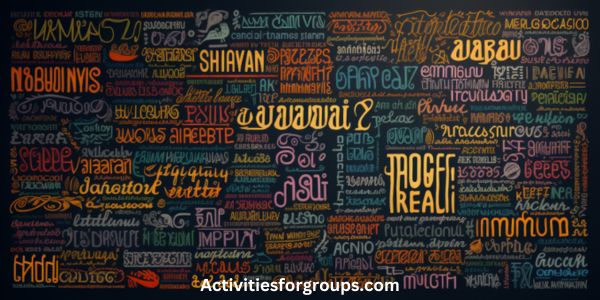Are you looking for ways to effectively facilitate a language learning group? You’ve come to the right place! This article will cover the key points of success for creating an engaging and productive language learning environment.

We’ll look at the importance of assigning roles and responsibilities, setting up a positive learning atmosphere, utilizing technology, implementing activities, and encouraging participation.
Let’s get started!
Assigning Roles and Responsibilities
You can ensure your language learning group is successful by assigning each member specific roles and responsibilities. Properly assigning roles and responsibilities can help keep the group on track and prevent confusion or misunderstandings. It can also help ensure that everyone in the group is contributing their best effort and that group dynamics remain positive and productive.
When assigning roles and responsibilities, consider the personalities and strengths of the members of the group. For instance, one person may have excellent organizational skills, while another person may have a natural talent for teaching. Assigning roles that match each individual’s strengths can help ensure that each role is carried out as efficiently as possible.
Time management is also an important factor when assigning roles and responsibilities. Assigning one person to be in charge of keeping track of the group’s progress can help keep everyone on track and ensure that tasks are completed on time. Delegating tasks can also help to keep the group organized and focused, allowing everyone to contribute their best effort.
In addition, be sure to encourage group members to share ideas and discuss any issues they may have. This can help to foster a sense of collaboration and camaraderie that can aid the group in achieving its goals.
Establishing a Positive Learning Environment
You can create a positive learning environment by fostering collaboration and camaraderie, and encouraging group members to share ideas. An effective language learning experience begins with an atmosphere where all group members feel respected and welcomed. Embracing diversity and recognizing the unique strengths and perspectives of each participant will help build trust and foster an environment of inclusion.
To keep a positive learning environment, it’s important to create a safe space for group members to ask questions, express their opinions, and take risks. This can be done by providing ample time for discussion and feedback, and by giving clear instructions on how to participate. Encourage group members to share their experiences and knowledge, and reward any progress.
It is also important to set clear expectations and boundaries from the beginning of the group. This includes establishing ground rules for how group members should behave and interact with each other, as well as addressing any potential issues that may arise. This will help ensure that everyone in the group is on the same page and will help keep the learning experience positive.
Finally, recognize and celebrate successes. Acknowledge individual and group accomplishments, and make sure everyone knows that their efforts are appreciated. By celebrating successes, group members will be more likely to stay engaged and motivated to continue learning.
Utilizing Technology to Enhance Learning

Have you ever thought about how technology can help your language learning group succeed? Technology can be a great asset to your language learning group, providing virtual tutoring, language apps, and other helpful resources. It can make the group more efficient and productive, allowing members to learn the language more quickly and effectively.
Using virtual tutoring is a great way to get personalized instruction and feedback from a professional language teacher. This can help members to stay motivated and learn the language more quickly. With language apps, members can practice their language skills independently while receiving feedback from the tutor.
In addition to virtual tutoring and language apps, technology can also be used to keep members connected and engaged with the group. Video conferencing allows members to interact with one another and with the group facilitator. This helps to keep the group cohesive and motivated.
Technology can also be used to create a more engaging learning environment. Interactive activities, games, and quizzes can be used to keep members interested and engaged. Technology can also be used to share resources, such as videos and audio recordings, with the group.
Implementing Structured Activities
By implementing structured activities, you can help your language learning group stay focused and engaged. One way to do this is to set up cultural exchange activities. These activities can help introduce the language and culture of the group’s country or region to the language learners. For example, you might host a movie night where everyone watches a film in the language they’re learning. This can help them gain an understanding of the cultural context of the language.
Another strategy is to create language exchange activities. These activities give members of the language learning group the chance to practice their language with native speakers. You can set up a system where members take turns being the ‘teacher’ and the ‘student.’ This way, everyone gets a chance to practice their language and exchange ideas.
You can also facilitate language learning activities that involve games. These can help the language learners practice their language skills in a fun and relaxed atmosphere. For example, you might create a game where the learners have to guess a word in the language they’re learning based on clues given by the native speakers.
Encouraging Participation and Engagement

Encouraging participation and engagement among your language learning group is key to their success. An effective facilitator should foster an atmosphere of comfort and inclusivity, so that everyone feels comfortable enough to express themselves.
To encourage participation, consider introducing activities that use role play, as it helps learners to practice the language as well as it allows them to act out different scenarios with each other. Open-ended questions can also be used to create conversation and help learners to practice their conversational skills.
When encouraging participation, it’s important to provide positive reinforcement to those who are actively engaged. This can be done by praising or recognizing those who make an effort to communicate in the target language, even if they make mistakes.
It’s also important to not single out anyone in the group, making sure to provide equal opportunity for everyone to speak.
Another way to ensure engagement in the language learning group is to provide a variety of activities for the learners. This can include games, debates, conversations, and other activities that encourage creativity and fun. It’s important to check in with the group throughout the activity, ensuring that everyone is engaged and on task.
Finally, facilitators should consider providing a safe space for learners to express themselves. If learners feel that their opinion is valued, and their ideas are appreciated, they’ll be more likely to be engaged with the language learning process.
Frequently Asked Questions [FAQs]
What Supplies Are Needed for a Language Learning Group?
You’ll need materials to help develop vocabulary and explore the cultural context of the language. Consider supplies like books, written exercises, audio recordings, and maps.
How Can I Assess the Progress of the Group?
Assess progress by gathering student feedback, observing language challenges, and tracking their successes.
How Can I Motivate the Group Members?
Motivate group members by offering rewards for progress and encouraging collaborative learning. Create a system that recognizes and rewards their hard work.
How Can I Manage Group Dynamics?
Manage dynamics by encouraging socializing, using icebreakers, and accounting for different learning styles. Allow for cultural exchange to foster understanding in the group.
How Often Should the Group Meet?
Frequency of meetups depends on group goals. Consider how often everyone needs to share resources and communicate effectively. Meet regularly to ensure everyone stays on track.
Conclusion
You now have the necessary tools to facilitate a language learning group effectively.
Assign roles and responsibilities, create a positive learning environment, use technology, provide structured activities, and encourage participation and engagement.
Your group will be on the road to acquiring a new language in no time!




Leave a Reply